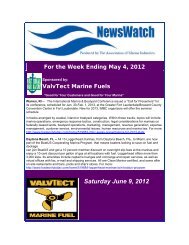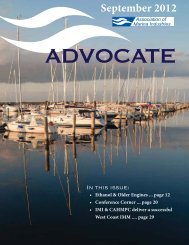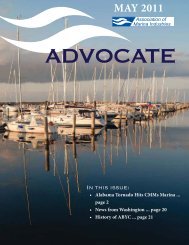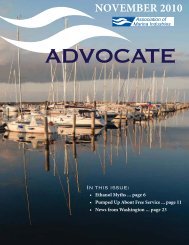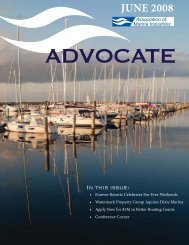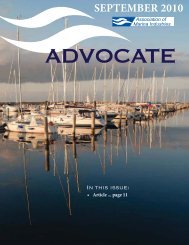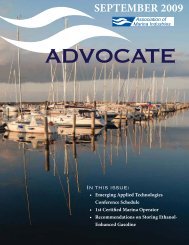Download a copy of AMI's Clean Marina best management practices ...
Download a copy of AMI's Clean Marina best management practices ...
Download a copy of AMI's Clean Marina best management practices ...
You also want an ePaper? Increase the reach of your titles
YUMPU automatically turns print PDFs into web optimized ePapers that Google loves.
Emergency Response Equipment<br />
Obtain and store emergency response equipment in an easily accessible location and where the greatest threat <strong>of</strong><br />
an emergency exists (i.e., oil spill kit on the fuel dock).<br />
Share Your Emergency Response Plans<br />
• Inform your local fire department and harbor master, if applicable, about your emergency response plans<br />
and equipment.<br />
• Let neighboring marinas know what resources are available at your marina.<br />
Petroleum Control<br />
Protect Petroleum Storage Tanks<br />
Check with your state rules on aboveground or underground storage tanks. Storage tanks holding 1500 gallons<br />
<strong>of</strong> diesel or 1400 gallons <strong>of</strong> gas must file Emergency Planning & Community Right to Know Act Tier II reports<br />
annually. Check with your state for online filing options.<br />
Install double-walled or vaulted fuel tanks with aboveground piping. Tanks should meet the following<br />
conditions (NFPA 30):<br />
• The capacity <strong>of</strong> the tank shall not exceed 12,000 gal (45,420 L).<br />
• All piping connections to the tank shall be made above the normal maximum liquid level.<br />
• Means shall be provided to prevent the release <strong>of</strong> liquid from the tank by siphon flow.<br />
• Means shall be provided for determining the level <strong>of</strong> the liquid in the tank. This means shall be<br />
accessible to the delivery operator.<br />
• Means shall be provided to prevent overfilling by sounding an alarm when the liquid level in the tank<br />
reaches 90 percent <strong>of</strong> capacity and by automatically stopping delivery <strong>of</strong> liquid to the tank when<br />
the liquid level in the tank reaches 95 percent <strong>of</strong> capacity. In no case shall these provisions restrict<br />
or interfere with the proper functioning <strong>of</strong> the normal or emergency vent.<br />
• Spacing between adjacent tanks shall be not less than 3 feet (0.9 m).<br />
• The tank shall be capable <strong>of</strong> resisting the damage from impact <strong>of</strong> a motor vehicle or suitable collision<br />
barriers shall be provided.<br />
• Where the interstitial space is enclosed, it shall be provided with emergency venting.<br />
• Locate above ground fuel tanks within a dike or over an impervious storage area with containment<br />
volumes equal to 1.1 times the capacity <strong>of</strong> the storage tank (s).<br />
• Design containment areas with spigots to drain collected materials.<br />
• Cover the tank with a ro<strong>of</strong> to prevent rainwater from filling the containment area.<br />
• Inspect tanks and piping regularly.<br />
Waves and Wakes<br />
• Locate fuel docks in protected areas. For safety reasons, all fueling stations should be accessible by boat<br />
without entering or passing through the main berthing area.<br />
• Provide a stable platform for fueling personal watercraft (PWC):<br />
- Prefabricated drive-on docks.<br />
- Modify an existing dock by cutting a v-shaped berth and covering it with outdoor carpeting.<br />
- Place the PWC fueling area at the end <strong>of</strong> the fuel pier to reduce conflict with larger boats.<br />
Maintain Fuel Transfer Equipment<br />
• Inspect and maintain transfer equipment and hoses in good working order. Replace hoses, pipes, and<br />
tanks before they leak.<br />
• Hard connect delivery nozzles.<br />
• Hang nozzles vertically when not in use so that fuel remaining in hoses does not drain out.<br />
6



